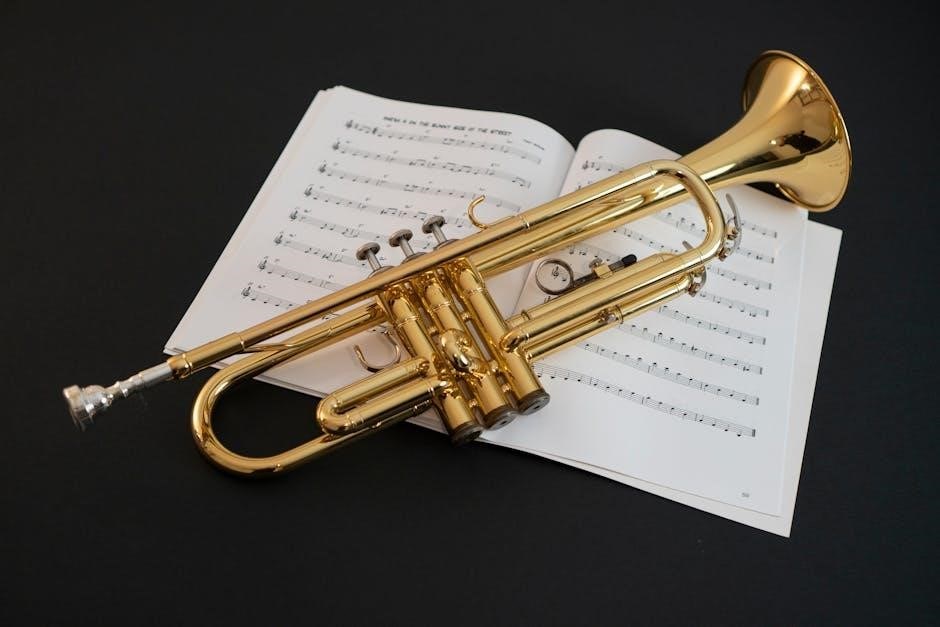A trumpet valve guide is essential for understanding and maintaining the instrument’s valves‚ ensuring optimal performance and sound quality․ Proper care and knowledge of valves are vital for all trumpet players․
Overview of Trumpet Valves
Trumpet valves are essential components of the instrument‚ enabling players to produce a wide range of notes by altering the air flow through the tubing․ Typically‚ a standard trumpet features three piston valves‚ though some professional models may include a fourth valve for extended range․ Each valve operates by diverting air through additional tubing‚ changing the pitch․ The valves are usually made of brass and require regular maintenance to ensure smooth operation․ Proper alignment and lubrication are crucial for optimal performance‚ as sticking or leaking valves can significantly affect playability and sound quality․ Understanding how these valves function is fundamental for any trumpet player‚ as they directly influence the instrument’s tonal clarity and responsiveness․ Regular care‚ such as cleaning and lubrication‚ helps maintain the valves’ efficiency and ensures the trumpet performs at its best․
Importance of Proper Valve Maintenance
Proper maintenance of trumpet valves is crucial for ensuring optimal performance‚ sound quality‚ and longevity of the instrument․ Neglecting valve care can lead to issues such as sticking valves‚ air leaks‚ or corrosion‚ which can hinder playability and tonal clarity․ Regular cleaning and lubrication prevent dust and moisture from accumulating‚ which can cause valves to malfunction․ Additionally‚ improper alignment or wear on valve casings can affect the instrument’s intonation and response․ Consistent maintenance not only enhances the trumpet’s performance but also prevents costly repairs․ Players should develop a routine of cleaning valves after each use and applying the right amount of lubrication to keep them functioning smoothly․ By prioritizing valve maintenance‚ musicians can ensure their trumpet remains in excellent condition‚ providing years of reliable service and exceptional sound quality․

Understanding Trumpet Valves
Trumpet valves are intricate components that regulate airflow‚ enabling precise pitch control and tone modulation․ They consist of casings‚ pistons‚ and ports‚ working in harmony to produce clear‚ resonant notes․ Proper function and alignment are key to the instrument’s mechanics and performance․
Structure and Mechanism of Trumpet Valves
Trumpet valves are precision-engineered components that play a crucial role in the instrument’s functionality․ They typically consist of a valve casing‚ piston‚ and ports․ The piston moves up and down within the casing‚ directing airflow through different ports‚ which alters the pitch․ The alignment and tight fit of these parts ensure smooth operation․ The valves are usually made of brass or nickel-plated materials for durability․ Proper lubrication and maintenance are essential to prevent sticking and air leaks‚ which can hinder performance․ Understanding the structure and mechanism of trumpet valves is vital for musicians to optimize their playing experience and maintain the instrument’s sound quality․ Regular cleaning and inspection help prolong the lifespan of the valves‚ ensuring they function seamlessly․ By grasping how these components work together‚ players can troubleshoot common issues and enhance their overall musical expression․
Types of Trumpet Valves: Piston vs․ Rotary
Trumpet valves are primarily categorized into two types: piston and rotary․ Piston valves‚ the most common and widely used‚ operate by moving a piston up and down within a cylindrical casing․ They are known for their quick action and precise intonation‚ making them ideal for jazz and commercial music․ Rotary valves‚ on the other hand‚ rotate within the casing and are commonly found in European orchestral trumpets․ They offer a warmer‚ richer tone and are favored by classical musicians․ The choice between piston and rotary valves often depends on the player’s musical style‚ personal preference‚ and the specific sound desired․ Both types require regular maintenance to ensure smooth operation and optimal performance․ Understanding the differences can help musicians select the right trumpet for their needs and enhance their playing experience․ Each valve type has its unique characteristics‚ catering to diverse musical demands across genres․ Proper care and selection are essential for achieving the best results․
How Valves Affect Sound Quality
Trumpet valves play a crucial role in sound production‚ directly impacting tone‚ intonation‚ and overall playability․ The efficiency and alignment of the valves influence the instrument’s ability to produce clear‚ resonant notes․ When valves function smoothly‚ they allow for precise pitch control and consistent airflow‚ resulting in a rich‚ vibrant sound․ Misaligned or sticking valves can lead to poor intonation‚ muffled tones‚ and discomfort for the player․ Properly maintained valves ensure optimal sound quality‚ while neglecting their care can degrade the instrument’s performance․ The valves’ material and design also affect the sound‚ with different alloys offering unique tonal characteristics․ Understanding how valves influence sound is essential for musicians to achieve their desired acoustic outcomes․ Regular maintenance and adjustments are vital to uphold the trumpet’s acoustic integrity and ensure a superior musical experience․

Maintenance and Care
Regular maintenance ensures trumpet valves perform optimally․ Cleaning and lubricating valves prevents damage and corrosion‚ while proper storage in a case keeps the instrument dry and secure‚ preserving sound quality and functionality․
Cleaning Trumpet Valves

Cleaning trumpet valves is a critical part of maintenance․ Start by disassembling the valves and soaking them in warm‚ soapy water to loosen grime․ Use a soft-bristle brush to gently scrub away dirt and oil residue․ Avoid harsh chemicals or abrasive materials that could damage the finish or corrode metal parts․ Rinse thoroughly with clean water and dry with a microfiber cloth to prevent water spots․ For internal valve casings‚ a valve cleaning snake or flexible brush can remove debris without causing harm․ Regular cleaning prevents corrosion and ensures smooth valve action․ Always follow manufacturer guidelines for specific cleaning solutions to maintain the longevity of your trumpet valves․ Proper care will enhance performance and maintain the instrument’s overall health․
Lubrication of Trumpet Valves
Lubrication is essential for smooth trumpet valve operation․ Use high-quality valve oil or grease to reduce friction and prevent corrosion․ Apply a few drops of oil to the valve stem and gently move the valve up and down to distribute evenly․ For rotary valves‚ apply grease sparingly to the bearing surfaces․ Avoid over-lubricating‚ as excess oil can attract dust and dirt‚ leading to sticking valves; Reapply lubricant after cleaning or if valves feel stiff․ Proper lubrication ensures valves move freely‚ maintaining precise control and consistent sound quality․ Regular lubrication also extends the lifespan of the valves by protecting them from wear․ Always use products specifically designed for trumpet valves to avoid damage․ If unsure‚ consult a professional for guidance․ Regular maintenance ensures optimal performance and longevity of your trumpet valves․
Repair and Replacement of Damaged Valves
Repairing or replacing damaged trumpet valves is crucial to maintain the instrument’s functionality and sound quality․ If a valve is dented‚ bent‚ or corroded‚ it may need professional repair or replacement․ Small dents can often be fixed by a technician‚ while severely damaged valves typically require replacement․ Corrosion can be addressed with thorough cleaning‚ but extensive damage may necessitate new parts․ Sticking or leaking valves can sometimes be resolved with adjustments or replacing worn-out felts and corks․ However‚ if issues persist‚ professional intervention is recommended․ Replacement valves should be sourced from reputable manufacturers to ensure compatibility and performance․ DIY repairs are risky and may cause further damage‚ so consulting a skilled technician is always advisable․ Timely repair or replacement of damaged valves prevents further deterioration and ensures the trumpet continues to play smoothly and sound its best․

Troubleshooting Common Issues

Identifying and resolving issues like air leaks‚ sticking valves‚ and misalignment is crucial for maintaining trumpet performance․ Regular inspections and adjustments can prevent major problems and ensure smooth functionality․
Identifying Air Leaks in Valves
Air leaks in trumpet valves can significantly affect performance‚ causing poor intonation and response․ To identify leaks‚ apply a small amount of soapy water to the valve casings․ Bubbles forming indicate escaping air․ Additionally‚ a hissing sound while playing or a loose feel in the valves can signal leaks․ Regularly inspect the valve seats and ensure they are tightly sealed․ If leaks persist‚ professional adjustment or replacement of worn gaskets may be necessary․ Addressing these issues promptly prevents further damage and maintains optimal playability․ Proper maintenance and periodic checks are essential for preserving the integrity of the trumpet’s valves and ensuring a leak-free performance․
Fixing Sticking Valves
Sticking valves can hinder trumpet performance‚ but they can often be fixed with proper care․ Start by cleaning the valves thoroughly․ Remove them and soak in warm‚ soapy water to dissolve grime and old oil․ Use a soft brush to scrub away stubborn residue‚ then dry completely․ Apply a high-quality valve oil evenly‚ ensuring smooth operation․ If sticking persists‚ check the alignment and adjust as needed․ Professional adjustment may be required for optimal playability․ Regular maintenance‚ including cleaning and lubrication‚ helps prevent sticking and ensures longevity․ Addressing the issue promptly maintains the instrument’s performance and prevents further damage․
Adjusting Valve Alignment
Proper valve alignment is crucial for smooth trumpet playability․ Misaligned valves can cause poor action and sound quality․ To adjust‚ start by inspecting the valve casing and piston alignment․ Use a screwdriver to gently loosen the valve cap and slide it off․ Carefully lift the valve piston and reposition it to ensure it aligns perfectly with the casing․ After realigning‚ reattach the cap and tighten it securely․ Test the valve by pressing it several times to ensure smooth‚ even movement․ If alignment issues persist‚ consult a professional technician for precise adjustments․ Regular checks and minor tweaks can prevent major problems‚ ensuring optimal performance and longevity of the trumpet valves․

Advanced Techniques
Explore customization and upgrading options to enhance trumpet performance․ Adjust valve settings for optimal playability and consider upgrading components for improved sound quality and responsiveness‚ ensuring a personalized playing experience․
Customizing Valve Settings for Optimal Playability
Customizing valve settings enhances playability by tailoring the trumpet to individual preferences․ Adjustments can include modifying spring tension‚ aligning valves for smooth action‚ and fine-tuning piston fit to reduce friction․ These tweaks ensure precise control and consistent performance‚ allowing players to focus on their technique without hindrance․ Proper customization can elevate the overall playing experience‚ making it more comfortable and enjoyable․ Regular adjustments by a professional technician are recommended to maintain optimal settings and prevent potential issues․ By personalizing valve settings‚ musicians can achieve a more responsive and reliable instrument‚ enabling them to deliver their best performances․ This level of customization is particularly beneficial for advanced players seeking to refine their sound and technical accuracy․ Ultimately‚ tailored valve settings contribute to a trumpet that feels and sounds its best‚ empowering the player to excel musically․
Upgrading Valve Components for Enhanced Performance

Upgrading trumpet valve components can significantly enhance performance by improving sound quality‚ playability‚ and durability․ Replacing outdated or worn-out parts with high-quality materials‚ such as nickel-plated brass or stainless steel‚ ensures smoother valve action and consistent tonal production․ Custom valve casings and precision-aligned pistons can reduce friction and air leaks‚ allowing for faster and more precise playing․ Additionally‚ upgrading to advanced valve guides or bearings can improve the instrument’s responsiveness and overall feel․ For players seeking a unique sound‚ specialized valve components like titanium or gold-plated pistons can offer distinct tonal characteristics․ Regular maintenance and professional installation of these upgrades are crucial to maximize their benefits․ By investing in premium components‚ musicians can elevate their trumpet’s performance‚ achieving a more refined and professional sound․ Always consult a skilled technician to ensure upgrades are tailored to the instrument’s specifications and the player’s needs․

Accessories for Trumpet Valves
Essential accessories for trumpet valves include high-quality oils‚ greases‚ and cleaning kits to maintain smooth operation․ Valve cases and storage solutions protect the instrument‚ ensuring longevity and optimal performance for musicians․
Valve Oils and Greases
Valve oils and greases are crucial for maintaining the smooth operation of trumpet valves․ High-quality oils reduce friction‚ preventing wear and tear‚ while greases provide long-lasting lubrication for pivot points․ Regular application ensures valves move freely and quietly‚ allowing precise control during performances․ Using the right type of lubricant is essential to prevent corrosion and maintain the instrument’s sound quality․ Proper lubrication also helps protect against dust and debris‚ which can cause sticking or air leaks․ Musicians should choose oils and greases specifically designed for brass instruments‚ as they are formulated to withstand the demands of frequent use․ Regular maintenance with these products ensures the trumpet valves function optimally‚ delivering consistent performance and tone․
Valve Cleaning Kits

Valve cleaning kits are essential tools for maintaining the hygiene and functionality of trumpet valves․ These kits typically include specialized brushes‚ cleaning cloths‚ and solutions designed to remove dirt‚ oil residue‚ and mineral buildup․ Regular cleaning prevents corrosion and ensures smooth valve action‚ which is critical for consistent playability․ Brushes in the kit are usually sized to fit snugly inside the valve casings‚ allowing thorough removal of debris without causing damage․ Cleaning cloths are often microfiber‚ gentle on surfaces yet effective at wiping away grime․ Some kits also include mild chemicals or solvents to dissolve stubborn deposits․ Proper use of these tools helps maintain the trumpet’s sound quality and prevents costly repairs․ Musicians should clean their valves regularly‚ ideally after each use‚ to keep the instrument in optimal condition․ A good cleaning kit is a worthwhile investment for any trumpet player seeking to preserve their instrument’s performance and longevity․
Valve Cases and Storage Solutions
Proper storage and protection of trumpet valves are crucial to maintain their functionality and longevity․ Valve cases and storage solutions are designed to safeguard the delicate components from damage‚ dust‚ and moisture․ Hardshell cases are ideal for protecting valves during transportation‚ offering durable exteriors and plush-lined interiors to prevent scratches․ Softshell cases provide lightweight‚ flexible storage options for everyday use․ Many cases feature compartments to organize valves‚ springs‚ and other small parts‚ ensuring everything stays in place․ Additionally‚ some storage solutions include padding or foam inserts to further cushion the valves․ Regularly storing valves in a clean‚ dry environment helps prevent corrosion and misalignment․ Investing in high-quality cases and storage solutions is essential for musicians who want to keep their trumpet in pristine condition․ Proper storage not only extends the life of the valves but also ensures optimal performance and sound quality when the instrument is played․
Understanding and maintaining trumpet valves is key to optimal performance․ Proper care‚ regular cleaning‚ and timely repairs ensure longevity and sound quality․ Apply these tips to preserve your instrument and enhance your playing experience․
Final Tips for Trumpet Valve Maintenance
Regular maintenance is key to extending the life of your trumpet valves and ensuring optimal performance․ Always clean valves after use to prevent residue buildup‚ and lubricate them regularly with high-quality valve oil․ Avoid using harsh chemicals or abrasive materials‚ as they can damage the finish or valve components․ Store your trumpet in a protective case when not in use to prevent accidental damage․ For sticky valves‚ apply a small amount of oil and gently work the valve up and down․ If valves become severely damaged‚ consult a professional technician for repairs or replacements․ Proper alignment and adjustment of valves can significantly improve playability and sound quality․ Customize your valve settings to suit your playing style for enhanced comfort and performance․ By following these tips‚ you can maintain your trumpet’s valves effectively and enjoy years of flawless playability․

